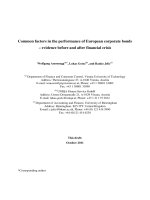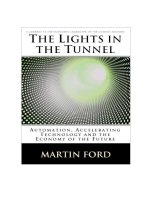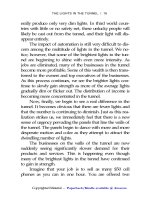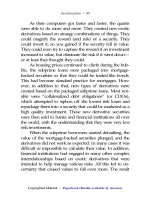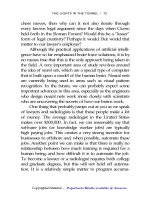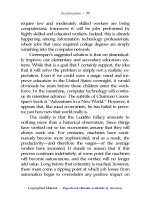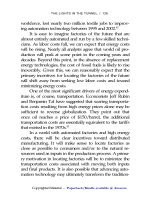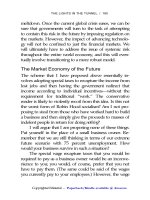Do value stocks outperform growth stocks in the U.S. stock market?
Bạn đang xem bản rút gọn của tài liệu. Xem và tải ngay bản đầy đủ của tài liệu tại đây (377.97 KB, 14 trang )
Journal of Applied Finance & Banking, vol. 7, no. 2, 2017, 99-112
ISSN: 1792-6580 (print version), 1792-6599 (online)
Scienpress Ltd, 2017
Do Value Stocks Outperform Growth Stocks in the U.S.
Stock Market?
Chongsoo An1, John J. Cheh2 and Il-woon Kim3
Abstract
The main objective of this paper is to compare the performance of value stocks and
growth stocks in the U.S. market using the enterprise value (EV) of each firm. Four
portfolios are formed, and the consistency of the performance of each portfolio is
examined under different market conditions. Changes in performance are also be tested
using returns on equity (ROE) as a proxy of future earnings. Finally, the impact of firm
size on performance is investigated. Using the stocks of 4,952 firms for the period 15
years from January 2, 1999 to December 31, 2014, it has been shown that the value stocks
outperform the growth stocks. These results are not changed with different holding
periods. The requirement of ROE above 5 percent has the impact on the performance of
growth stocks. In terms of firm size, it appears small firms are more profitable than large
firms.
JEL classification numbers: G11, G14
Keywords: Value Investing Strategy, Value Stock, Growth Stock, Enterprise Value
1 Introduction
Various investment strategies have been developed and used by professional investors to
earn high returns in the stock market. Among them, value investment strategy and growth
investment strategy have probably been most popular in the investment community
around the world. The difference between two strategies comes from different views on
value ratios, such as Book/Market (B/M) ratio and Earning/Price (E/P) ratio. Value
investors look for stocks with high value ratios because they believe that these stocks
have strong current fundamentals for the book value and earnings power but incorrectly
1
Gangneung-Wonju National University, Korea.
The University of Akron, U.S.A.
3
The University of Akron, U.S.A.
2
Article Info: Received : December 5, 2016. Revised : January 3, 2017.
Published online : March 1, 2017
100
Chongsoo An, John J. Cheh and Il-woon Kim
undervalued by the market now. Hence, share prices are expected to rise in the future
when the valuation error is corrected by the market. Growth investors, however, buy
stocks with future growth potential which can lead to a significant increase in stock prices
in the long run. Growth stocks are expected to be currently trading at prices higher than
their intrinsic value because of the growth potential and, accordingly, their value ratios are
generally low. The idea behind the growth strategy is the efficient market hypothesis
which states that the current stock price reflects all the information available about the
firm and, therefore, the current price is most reasonable at that point of time.
Clearly, there are arguments on both sides and there is no “right” answer to the stock
investment (Investopedia Staff, 2015). Since Fama and French (1988, 1992 and 1998)
made an argument that there are permanent and temporary components of stock prices
and abnormal profits could be realized by investing in value stocks, many empirical
studies have been done to investigate this issue. As will be reviewed in the next section,
however, most of these studies used B/M ratio and/or E/P ratio which are based on the
equity market capitalization to identify value stocks and growth stocks. In our study, we
use the enterprise value (EV) as a measure of a firm’s value instead of only using the
market capitalization. EV is generally measured by market value of equity plus market
value of debt minus cash. This has been highly advocated by investment professionals in
measuring firm value. For example, Faulkenberry (2015) states that enterprise value is a
key metric for value investors because it best represents the total value of a company and
is capital structure neutral. EV can be used for calculating enterprise value ratios that
provide important comparisons between companies. It is also argued (Forbes.com, 2012)
that, by using enterprise value instead of market capitalization to look at the value of a
company, investors get a more accurate sense of whether or not a company is truly
undervalued. For an indicator of firm’s profitability, we use earnings before interest and
taxes (EBIT) which represents financial performance of a firm better than net earnings,
and as a measure of the firm value, the book value is also used.
The main objective of this paper is to compare the performance of value stocks and
growth stocks in the U.S. market over the period of 1999-2014 using EV of each firm.
Specifically, we examine the following four questions in this paper:
1. Do value stocks outperform growth stocks based on a new selection method?
2. How consistently does the performance of each portfolio behave under different
market conditions?
3. Is there any change in the performance of portfolios with the consideration of return
on equity (ROE) as a proxy of future earning?
4. Does the size of the firm matter in the performance of portfolios?
Previous studies have demonstrated superior performance of value stocks, but the
existence of value premium has not been properly explained yet. This study will provide
further evidence on the comparison of value stocks and growth stocks, and address
important issues, such as market conditions, ROE, and firm size which can be useful to
explain the premium (if it exists). This study will also be different from previous studies
in using EV ratios instead of equity market capitalization ratios for the classification of
value stocks and growth stocks.
Do Value Stocks Outperform Growth Stocks in the U.S. Stock Market?
101
2 Literature Review
Basu (1977) shows that value stocks with low P/E (Price/Earnings) ratios outperform
growth stocks with high P/E ratios. Lakonishok, Shleifer and Vishny (1994) and Fama
and French (1998) also show that there is strong evidence of a value premium in returns.
Firms with high B/M or E/P ratios have higher average returns than firms with low B/M
or E/P ratios. Cheh, Kim and Zheng (2008) examine the value investing hypothesis using
the P/E ratio as a benchmark in finding cheap stocks relative to their earnings streams.
They have found that investors can beat market averages by buying low P/E stocks and
selling them after the prices of purchased stocks reach a certain level. For the Japanese
market, Chan, Hamao and Lakonishok (1991) and Capaul, Rowley and Sharpe (1993)
demonstrate that both B/M and E/P ratios have a strong role in explaining the
cross-section of average returns. Athanassakos (2009), using P/E and P/BV (price to book
value) in the Canadian market, found strong value premium over the period of 1985-2005
consistently in both bull and bear markets, as well as in recessions and recoveries.
Basically, all these studies have shown that value stocks outperform growth stocks in the
market as a whole.
However, the explanations about the existence of value premium are divided, as noted
below by Fama and French (1998):
“Lakonishok, Shleifer and Vishny (1994) and Haugen (1995) argue that the value
premium arises because the market undervalues distress stocks and overvalues growth
stocks. When these pricing errors are corrected, distress stocks have high returns and
growth stocks have low returns. Fama and French (1993, 1995 and 1996) argue that the
value premium is a compensation for risk missed by the capital asset pricing model
(CAPM) of Sharpe and Lintner (1965).”
In addition, there are limitations in using B/M and E/P ratios only to form an investment
strategy, and the emphasis on low prices can mislead investors. Damodaran (2012) points
out some of these limitations of an investment strategy using B/M or E/P ratio. He finds
that while high ratio stocks may include a number of undervalued firms, it may also
contain other less desirable firms. Those firms with prices well below book value or
earnings are more likely to be in financial trouble and go out of business. Investors,
therefore, should evaluate whether the additional returns can be made by such firms to
justify the additional risk taken by investing into these firms. Greenblatt (2010) also
discusses the risk of using B/M or E/M ratio. Each firm has different levels of debt and
different tax rates. The high E/P or B/P ratios may yield riskier stocks than average stocks
that have lower debt and lower tax. When a firm has borrowed a substantial amount, it is
possible that its stock will be traded in such a way to generate a high E/P or B/M ratio. If
investors pick stocks with high E/P or B/M ratio, they may end up with portfolios of the
most highly levered firms with high tax burdens in each sector.
3 Methodology and Data Analyses
Due to the limitations of using E/P and B/M ratios in many prior studies as mentioned in
the previous section, we use a more discerning method in defining value and growth
stocks. In particular, the enterprise value (EV) is used instead of the price of equity which
represented total market capitalization of a firm. EV is important for the purpose of our
study because EV takes into account both the price paid for the equity in a firm as well as
102
Chongsoo An, John J. Cheh and Il-woon Kim
the debt financing used to help generate operating earnings. In addition, earnings before
interest and taxes (EBIT) is used as a measure of the profit of the sample firms. EBIT is
an indication of a firm’s ability to generate profit from its operations, ignoring tax burden
and capital structure which can differ across the sample firms. Hence, using EBIT, the
results of this study will not be subject to different levels of debt and/or different tax rates
of sample firms. Along with EBIT, the book value (BV) of the firm is also used in this
study. BV represents net worth of a firm which is the difference between total assets and
total liabilities. Hence, the following two ratios are used in this study to identify value
stocks and growth stocks:
● EBIT/EV = earnings before interest and taxes / (market value of equity + net
interest-bearing debt) and
● BV/EV = book value / (market value of equity + net interest-bearing debt),
where EV is more specifically defined and measured as market capitalization + total
debt + value of preferred equity + minority interest (redeemable + non redeemable) - cash
& equivalents.
Even though the EBIT/EV multiple is not commonly used in academic research to
measure a firm’s return on investment, it does have certain advantages in comparing
companies. First, using EBIT as a measure of profitability eliminates the potential
distorting effect of differences in tax rates. Secondly, using EBIT/EV normalizes for the
effects of different capital structures (Investopedia.com). BV/EV ratio is a relative
measure of book value and total market value of the business. A low BV/EV ratio
indicates that the market assigns a higher value to the company due to the earnings power
of the company's assets. Nearly all consistently profitable companies will have market
values greater than book values (Investopedia.com 2015).
Next, ROE is used as a benchmark in finding good stocks relative to their future earnings
streams. Certain requirements must be met to be included in sample firms whose business
will be good in the future. The importance of ROE in stock investment has been well
recognized by practitioners (The Motley Fool, 2016):
“Disarmingly simple to calculate, return on equity is a critical weapon in the
investor's arsenal, as long as it's properly understood for what it is. ROE
encompasses the three pillars of corporate management -- profitability, asset
management, and financial leverage. By seeing how well the executive team
balances these components, investors can not only get an excellent sense of whether
they will receive a decent return on equity but can also assess management's ability
to get the job done.”
Based on the results of some prior studies, other factors which can affect portfolio
performance are also considered to control confounding effects: trading frequency, market
conditions, and firm’s size. In terms of trading frequency, Cheh et al. (2008)
demonstrated that high E/P ratio vs. low E/P ratio in forming an investment strategy was
far more complex than it appeared. They found that market conditions and trading
frequency mattered in the interplay of high E/P vs. low E/P stocks. During the rising bull
market, risk-adjusted returns of low E/P stocks were better than high E/P stocks when
investors rebalanced their E/P portfolios annually. But more frequent rebalancing of the
E/P portfolios tended to improve the performance of high E/P portfolios, while lowering
the performance of low E/P portfolios. Senchack and Martin (1987) reported that the
market conditions had the impact on the returns of portfolio. They examined how
consistently the two strategies (value and grow stocks) behaved over several market
Do Value Stocks Outperform Growth Stocks in the U.S. Stock Market?
103
cycles. It has been found that value stocks offered better downside protection as well as
comparable upside potential overall. Banz (1981) reported that the size of a firm could
have an impact on the return of the portfolio. It has been shown that small firms generated
the excess return and that, as the firms became bigger, the excess returns disappeared.
As the initial sample in our study, we used all stocks of 6,673 firms listed in Portfolio1234
which were supplied by Compustat, Standard & Poors, CapitalQ, and Reuters during the
study period from January 2, 1999 to December 31, 2014. Stocks that were not actively
traded during the period were deleted, with the final sample of 4,952 firms each year. For
each firm, we computed EBIT/EV and BV/EV at the beginning of each calendar year.
The firms were then classified into value stocks and growth stocks based on the following
criteria using the program available in Portfolio123:
Value portfolio: Frank(EBIT/EV) >=75 or Frank(BV/EV) >=75
Growth portfolio: Frank(EBIT/EV) <=25 or Frank(BV/EV) <=25
Stocks in the top 25th percentile with respect to EBIT/EV ratio or BV/EV ratio were
included in value portfolios with the sample size of 1,364 firms and 1,256 firms,
respectively, and those in bottom 25th percentile in growth portfolios with 840 firms
measured by EBIT/EV ratio and with 733 firms as measured by BV/EV ratio. The high
ratio of EBIT/EV or BV/EV indicated that the firm's stock was undervalued, and an
excess return was expected when the market was recovered and the firm's assets were
fairly valued by the investors. The performance results of each portfolio were computed
and compared to the performance of S&P 500 as a proxy of the market index. The return
performance of each portfolio was then computed using 3-months, 6-months and 1-year
rebalancing frequency data which were available at the backtesting application form of
Portfolio123, and their financial results were compared to the performance of the S&P
500. Next, ROE was introduced as a proxy for future earnings in order to eliminate the
firms whose future growth was expected to be low or negative. Finally, the size effect was
tested using the market capitalization of each firm.
4 Empirical Results
Table 1 shows the market capitalization of value stocks and growth stocks at the end of
the study period, along with the sample size of each portfolio. The median market value
of value stocks is $941.39 million based on EBIT/EV and $707.48 million based on
BV/EV, and $89.28 million and $227 million respectively for growth stocks. Apparently,
value firms are much larger than growth firms and the difference is even bigger when
EBIT/EV is used for classification.
4
Portfolio123 provides the data on financial statements for retail investors to do basic financial
analyses and also supplies a sophisticated high-level computer language that allows professional
investors to build custom formulas and experiment with various value investing strategies. In
addition, each star model has been backtested with screening rules and ranking systems.
Portfolio123 also uses extensive databases from several data vendors and different investment
strategies expressed in formula. Investors can make analyses of their investment strategies
applying different screening or ranking methods. See portfolio123.com (2016) for more details.
104
Chongsoo An, John J. Cheh and Il-woon Kim
Table 1: Market capitalization of value and growth stocks ($million)
Median market value
Portfolios
Value stocks
Growth stocks
Based on EBIT/EV
$941.39
(1,364 firms)
$89.28
(840 firms)
Based on BV/EV
$707.48
(1,256 firms)
$227.00
(733 firms)
4.1 The Return Behavior of Value and Growth Portfolios
The annualized returns of value and growth portfolios and S&P 500 during the study
period are presented in Table 2. Annualized returns are the returns that should have been
realized every year to earn total returns during the whole period. Clearly, the value stocks
outperform the growth stocks by a considerable margin. The value portfolio based on
EBIT/EV has annualized returns of 15.12 percent while growth portfolio based on
EBIT/EV has annualized returns of 12.23 percent. Value stocks outperformed growth
stocks by 23.63 percent. Similar results can be observed based on BV/EV. In terms of the
risk, the value stocks also beat the growth stocks with lower risk. The value portfolio
based on EBIT/EV has a systematic risk of 0.91 as measured by beta and total risk of
17.34 percent as measured by standard deviation of returns while the growth portfolio has
a systematic risk of 1.22 percent and total risk of 32.72 percent. Based on BV/EV, growth
stocks also have a slightly riskier than value stocks. In sum, value portfolios based on
either EBIT/EV or BV/EV generated much higher returns than growth portfolios with
lower risk. All four portfolios performed significantly better than S&P 500 (3.35 percent)
in terms of returns, but with much higher risk than the market.
Table 2: Risk-return characteristics of value and growth portfolios: annual results
Portfolios
Value stocks
Growth stocks
Annualized
Beta
Standard Annualized
Beta
Standard
return
deviation
return
deviation
Based on
15.12%
0.91%
17.34%
12.23%
1.22%
32.72%
EBIT/EV
Based on
BV/EV
16.09%
1.02%
22.38
%
S&P500
Annualized return: 3.35%
Standard deviation: 15.59%
12.92%
1.15%
24.63%
4.2 The Performance of Portfolios with Different Holding Periods
To examine the effect of using different holding periods, each portfolio was rebalanced
with the holding period of 6 months and 3 months, and the results are shown in Table 3.
Note that returns and standard deviations reported in Table 2 were obtained from annual
rebalancing.
As we rebalance the portfolios more frequent, it is interesting to note that the returns are
Do Value Stocks Outperform Growth Stocks in the U.S. Stock Market?
105
not necessarily going up and that, in some cases, returns are actually decreasing. For
example, returns of growth stocks based on EBIT/EV are consistently decreasing: 12.23
percent with one year rebalancing, 8.59 percent with 6-month rebalancing and 7.83
percent with 3-month rebalancing. Returns based on BV/EV are somewhat mixed:12.92
percent, 10.50 percent, and 12.47 percent, respectively. For value stocks, returns based on
BV/EV are decreasing from 16.09 percent with one year rebalancing, to 14.41 percent
with 6-month rebalancing, and to 14.25 percent with 3-month rebalancing. Returns based
on EBIT/EV are mixed: 15.12 percent, 14.40 percent, and 15.34 percent, respectively.
However, standard deviations are all increasing without exceptions as we increase the
rebalancing frequency.
Table 3: Returns and risk for 6-month and 3-month rebalancing
Portfolios
Value stocks
Annualized
return
6-month
rebalancing
Based on EBIT/EV
Based on B/EV
3-month
rebalancing
Based on EBIT/EV
Based on BV/EV
S&P500
14.40%
14.41%
Standard
deviation
17.61%
23.16%
15.34%
18.48%
14.25%
24.43%
Annualized return: 3.35%
Standard deviation: 15.59%
Growth stocks
Annualized
return
Standard
deviation.
8.59%
10.50%
34.05%
25.33%
7.83%
12.47%
35.83%
26.57%
In all cases, value stocks outperform the growth stocks by a significant margin with lower
risks. Considering transaction costs and slight increase in risk, the holding period seems
to have no significant impact on the performance of portfolios. In the subsequent sections,
all discussions are based on the annual rebalancing.
4.3 Return Distribution
To provide more insight into how the relative performance might be explained, Table 4
contains various descriptive statistics on the frequency distributions of annualized returns
for value and growth portfolios. Note that the value portfolio’s 50th percentile (Mid)
return as well as the 25th percentile (Q1) return are significantly higher than those of the
growth portfolio. While percentile the value and growth portfolios have similar returns at
the 75th percentile (Q3), the growth portfolios have a greater positive skew for their
returns. It means that the value portfolios tend to produce fewer big losers and less big
winners than the growth portfolios. In the last column, the skewness of value stocks based
on EBIT/EV is slightly negative while that of other three portfolios is positive. That
means, returns of value portfolio based on EBIT/EV is skewed to the left, when returns of
other portfolios are skewed to the right.
106
Chongsoo An, John J. Cheh and Il-woon Kim
Table 4: Distributional properties of returns with value and growth portfolio
based on EBIT/EV and B/EV
Quantiles
Min
Q1
25%
Mid
50%
Q3
75%
-38.73
-50.16
3.9
2
-0.40
15.67
14.32
-44.6
-50.2
-0.18
-4.66
12.04
4.27
Max
Range
Q1-Q3
Skew
27.60
26.88
62.44 101.17
107.62 157.78
23.68
27.28
-0.14
0.89
27.68
23.11
95.9
115.7
27.86
27.77
0.88
1.24
Based on
EBIT/EV
Value Stocks
Growth Stocks
Based on BV/EV
Value Stocks
Growth Stocks
140.5
165.9
Note: Q1 25% and Q3 75% stand for top 25% quantile and top 75% quantile in terms of
returns, respectively, and Mid 50% stands for the median value.
Range = Max (maximum return) – Min (minimum return)
Let’s compare the relative performance of the EBIT/EV and B/EV strategies. Consider
the annual results in Table 4. The 25th percentile and median returns of the value
EBIT/EV portfolio are 3.92 percent and 15.67 percent, respectively, which are higher than
the corresponding returns of the value B/EV portfolio. These returns are -0.18 percent and
12.04 percent, respectively, indicating a less downside risk with the value EBIT/EV
portfolio. While the EBIT/EV and BV/EV portfolios have similar returns at the 75th
percentile, the BV/EV strategy has a greater positive skew for their returns. The
differences in their relative performance seem to be explained by the fact that the
EBIT/EV strategy provides more downside protection, but not much upside potential
overall.
4.4 The Performance of Portfolios over Market Cycles
In this section, we examine how consistently value and growth portfolios behave over the
up and the down markets. Note that our test period begins from the year of 1999 and ends
in the latest bull market year of 2014. The annual returns of value and growth stocks
based on EBIT/EV are graphically compared in Figure 1 using S&P 500 as the market
index over the period, and the returns in Figure 2 are based on BV/EV. These figures
mirror the results in Table 2 and Table 4 which indicate that the portfolios returns are
more volatile than market returns, and value portfolio returns are less volatile than those
of the growth portfolio.
Do Value Stocks Outperform Growth Stocks in the U.S. Stock Market?
107
Figure 1: Market returns of value and growth portfolios based on EBIT/EV
Figure 2: Market returns of growth portfolios based on BV/EV
With respect to returns, the value portfolio based on EBIT/EV outperforms the market in
13 out of 16 years as shown in Figure 1, and the growth portfolio outperforms the market
108
Chongsoo An, John J. Cheh and Il-woon Kim
in seven out of 16 years. Value portfolio returns are higher than growth portfolio returns
in 14 out of 16 years, and the growth portfolio outperformed the value portfolio only in
two years, but with a huge margin: 54.84 percent and 144.40 percent in 2002 and 64.34
percent and 128.10 percent in 2008 for the value portfolio and growth portfolio,
respectively. For five years when the market suffered a loss, the value portfolio did
always better than the growth portfolio. Figure 2 which is based on BV/EV, shows similar
results with a few minor differences. The value portfolio outperformed the market in 11
years and the growth portfolio in nine years. Value portfolio returns are higher than
growth portfolio returns only in 11 (versus 14 years based on EBIT/EV) out of 16 years,
and the growth portfolio outperformed the value portfolio in five years but without a big
difference in margin. For example, returns were 96.03 percent and 116.00 percent in 2002
and 86.07 percent and 96.42 percent in 2008 for the value portfolio and growth portfolio,
respectively.
4.5 The Performance of Portfolios with a Requirement for High Return on
Equity
As an attempt to improve the portfolio performance, we used the return on equity (ROE)
as a benchmark in selecting our sample firms. ROE is a profitability ratio that has been
widely used in portfolio management to measure a firm’s ability to generate profits using
the investments of shareholders. We computed ROE of each firm and selected the firms
with ROE greater than or equal to 5 percent. From the original sample, the firms with
ROE less than 5 percent were excluded. Final sample consisted of 1,099 firms in the
value portfolio and 42 firms in the growth portfolio based on EBIT/EV, and 420 firms and
229 firms, respectively, based on BV/EV. The results are shown in Table 5.
Portfolios
Based on
EBIT/EV
Based on
B/EV
S&P500
Table 5: Annualized returns of stocks with ROE above 5%
Value stocks
Growth stocks
Annualized
Standard
Annualized
Standard
return
Deviation
return
Deviation
14.19%
16.77%
15.28%
22.68%
15.12%
16.98%
12.56%
19.04%
Annualized return: 3.35%
Standard deviation: 15.59%
Overall, it is surprising to see that the returns have not been much improved, comparing
to the results without the ROE benchmark as presented in Table 2. In fact, the only
portfolio with improvement was the growth portfolio based on EBIT/EV: 15.2 percent
(Table 5) and 12.23 percent (Table 2) with and without the ROE benchmark, respectively.
This is also the only growth portfolio that outperformed the value portfolio in our study. It
should be also noted that standard deviations of all portfolios with the ROE benchmark
are lower than those without. Apparently, the stability of performance has improved
particularly for growth stocks. These results are intriguing in terms of growth stocks. It
would be a good investment strategy to buy growth stocks with high ROE based on
Do Value Stocks Outperform Growth Stocks in the U.S. Stock Market?
109
EBIT/EV to expect a high return without high volatility.
4.6 The Size Effect of the Performance of Portfolio
It can be argued that large firms have certain inherent advantages over small or
medium-sized firms in terms of return and risk. Among other things, lager firms have
access to greater amounts of funds, higher quality employees, and well established
customers. Hence, we dropped small firms from the sample and examined the returns and
risk of large firms. As the measure of firm size, the market capitalization was used which
is the total dollar market value of all outstanding shares. It is a measure commonly used in
the investment community as a surrogate of firm size instead of total sales or total assets.
The initial threshold of market capitalization was $250 million, and the large firms above
the amount were 965 value firms and 181 growth firms based on EBIT/EV, and 560 value
firms and 410 growth firms based on BV/EV. The portfolio performance of these large
firms are presented in Table 6. As another threshold, the amount of $500 million was used
due to the subjective nature of the definition of large firms, reducing the sample
significantly to 789 value firms and 106 growth firms based on EBIT/EV and 397 firms
and 349 firms, respectively, based on BV/EV. Table 7 shows the performance of these
large firms.
Table 6: Annualized returns of the firms with market capitalization above $250 million
Portfolios
Value stocks
Growth stocks
Annualized
Standard
Annualized
Standard
return
Deviation
return
Deviation
Based on
13.42%
18.32%
5.42%
27.07%
EBIT/EV
Based on
11.79%
21.23%
7.99%
22.16%
B/EV
S&P500
Annualized return: 3.35%
Standard deviation: 15.59%
Table 7: Annualized returns of the firms with market capitalization above $500 million
Portfolios
Value stocks
Growth stocks
Annualized
Standard
Annualized
Standard
return
Deviation
return
Deviation
Based on
13.47%
18.30%
5.04%
24.82%
EBIT/EV
Based on
B/EV
S&P500
11.76%
20.66%
8.41%
21.65%
Annualized return: 3.35%
Standard deviation: 15.59%
Table 6 shows that value stocks outperform growth stocks by a considerable margin. The
difference is especially significant with the EBIT/EV classification: 13.42 percent for
value stocks and 5.42 percent for growth stocks, generating the value premium as much as
8 percent. In fact, the returns of four portfolios using large firms are lower than those
110
Chongsoo An, John J. Cheh and Il-woon Kim
using all sample firms in Table 2. An implication is that small firms are generally more
profitable than large firms. It should be noted that the decrease in returns for growth
stocks is particularly significant: from 12.23 percent to 5.42 percent based on EBIT/EV
and from 12.92 percent to 7.99 percent based on BV/EV. An implication is small firms
have much more growth potential than large firms. As expected, standard deviations of
large firms are generally smaller than those of small firms. Increasing the threshold to
$500 million to become large firms, as shown in Table 7 does not make much difference
in terms of return and risk.
6 Conclusion and Implications
The main objective of this paper was to compare the performance of value and growth
stocks with respect to their returns and risk. We used two bases using the enterprise value
(EV) to classify value stocks and growth stocks: EBIT/EV and BV/EV. Consistency of
the performance of each portfolio was examined under different market conditions.
Changes in performance were also tested using returns on equity (ROE) as a proxy of
future earnings, and finally, the impact of firm size on performance was investigated.
The overall results of this study show that the value stocks outperform the growth stocks
as was found in many previous studies. Owning a portfolio of value stocks would have
achieved an annualized return of 15 percent or higher during the study period of 16 years
when the market's annualized return for S&P 500 was 3.35 percent. Growth stocks
generated returns above 12 percent per year during the same period. Generally, there is
strong evidence of a value-growth premium in the portfolio returns in the U.S. stock
market.
With the different holding periods, the returns and risk of the value portfolio have not
changed much. Risks are increased with growth stocks as the holding period is shortened.
The requirement of ROE above 5 percent has the impact on the performance of growth
stocks. The growth portfolios based on EBIT/EV registered higher returns than the value
portfolios. However, when we narrowed the sample to the large firms, the value stocks
tend to outperform the growth stocks.
Our study has several practical implications that are useful in the investing strategy. First,
high EBIT/EV and BV/EV ratios may be a good indicator of the underpriced security.
EBIT/EV and BV/EV ratios are a more discerning approach, compared to E/P and B/M
ratios which have been used widely. It looks that using E/P and B/M to screen stocks is a
rather simplistic approach in buying and selling decisions. With EBIT/EV and BV/EV
ratios, we can utilize other fundamental data about the firm's debt position, tax, enterprise
value and future earnings. Second, ROE can be useful in finding good stocks relative to
firm’s future earnings streams. As a firm's earning is expected to grow, the performance
of the growth stock also improves. It may be a good investment strategy to buy growth
stocks with high future earnings. Finally, it should be noted that using the EBIT/EV and
BV/EV ratios is one of the investment valuation methods available and should be used
carefully with the understanding of the method in the context of the pros and cons of such
various valuation methods. Future studies may use a more elaborate attribute-based
system containing sets of screens that might produce even better results.
Do Value Stocks Outperform Growth Stocks in the U.S. Stock Market?
111
References
[1] G. Athanassakos, “Value versus growth stock returns and the value premium: the
Canadian experience 1985-2005,” Canadian Journal of Administrative Sciences, 26
(2), 2009, pp. 109-121.
[2] R. W. Banz, “The relationship between return and market value of common stocks,”
Journal of Financial Economics, 9 (1), 1981, pp. 3-18.
[3] S. Basu, “Investment performance of common stocks in relation to their
price-earning ratios: a test of the efficient market hypothesis,” Journal of Finance 32
(3), 1977, pp. 663-682.
[4] C. Capaul, I. Rowley and W.F. Sharpe, “International value and growth stock
returns,” Financial Analysts Journal, v49, 1993, pp. 27-36.
[5] J. Cheh, D. Kim and G. Zheng, “Investing in growth stocks vs. value stocks: does
trading frequency matter?” The Journal of Investing, Summer 2008, 17 (2), pp.
75-92.
[6] Econ Review, “Japanese stock market crash 1989,”
[7] access on October 2015,
[8] A. Damodaran, “Value investing: investing for grown ups?” 2012, Unpublished
paper.
[9] E. Fama and K. R. French, “Permanent and temporary components of stock prices,”
Journal of Political Economy, 96 (2), 1988, pp. 246-273.
[10] E. Fama and K. R. French, “The cross-section of expected returns,” Journal of
Finance, v47(2), 1992, pp. 427-466.
[11] E. Fama and K. R. French, “Common risk factors in the returns on stocks and
bonds,”Journal of Financial Economics, v33, 1993, pp. 3-56.
[12] E. Fama and K. R. French, “Size and book-to-market factors on stocks and
bonds,”Journal of Finance, v50, 1995, pp. 131-155.
[13] E. Fama and K. R. French, “Multifactor explanations of asset pricing
anomalies,”Journal of Finance, v51, 1996, pp. 55-84.
[14] E. Fama and K. R. French, “Value versus growth: the international evidence,”
Journal of Finance, 53 (6), 1998, pp. 1975-1999.
[15] K. Faulkenberry, “Enterprise value (EV) and calculating enterprise value ratios,”
Investment
Analysis
accessed on October 6, 2015.
[16] Forbes.com,
“Using
enterprise
value
to
compare
companies,”
/>pare-companies/, accessed on October 6, 2015.
[17] J. Greenblatt, “The little book that beats the market, John Wiley & Sons, 2010.
[18] R. Haugen, “The new finance: the case against efficient markets (Prentice-Hall,
Englewood Cliffs, N.J.), 1995.
[19] Investopedia Staff, Investopedia.com
accessed
on October 5, 2015
[20] Investopedia.com, and
/>alue.asp, accessed on October 6, 2015.
[21] J. Lakonishok, A. Shleifer, and R.W. Vishny, “Contrarian investment, extrapolation
and risk,” Journal of Finance 49 (5), 1994, pp. 1541-1578.
112
Chongsoo An, John J. Cheh and Il-woon Kim
[22] J. Lintner, “The valuation of risk assets and the selection of risky investments in
stock portolio and capital budgets,” Review of Economics and Statistics, 47 (1),
1965, pp. 13-37.
[23] Portfolio123.com, on line access in 2016.
[24] A. J. Senchack, and J. D. Martin, “The relative performance of the PSR and PER
investment strategies,” Financial Analysts Journal, March-April, 43 (2), 1987,
pp.46-56.
[25] W. F. Sharpe, “Capital asset prices: a theory of market equilibrium under conditions
of risk,” Journal of Finance, 19, 1964, pp. 425-442.
[26] L. H. Summers, “Does the stock market rationally reflect fundamental values?”
Journal of
Finance, July, 41 (3), 1986, pp. 591-601.
[27] The Motley Fool,
/>accessed on February 27, 2016.

